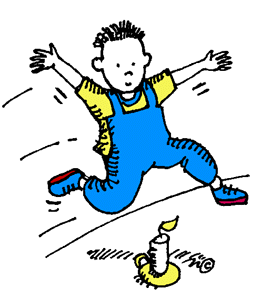Ten Ways to Celebrate National Poetry Month with a Toddler
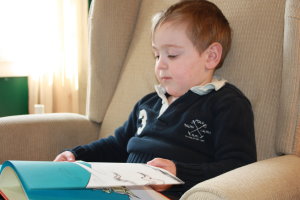
by Joe "Silly" Sottile
“And will you succeed?
Yes! You will indeed!
(98 and 3/4 percent guaranteed)”
-Dr. Seuss
National Poetry Month, which starts April 1st, is a splendid time to let poetry blossom in your household and in the young hearts of your children. What follows are nine tips to spread and nurture the joy of poetry in your home.
1. Let nursery rhymes lead the way.
Nursery rhymes help children focus on language, rhythm and syllables in words. Learning sounds and syllables encourages children to become readers. Showering young kids with nursery rhymes teaches more than you might anticipate. As a classroom teacher for thirty-three years, I’ve discovered that nursery rhymes teach the essence of PLOT—that is, PLenty Of Tension and more. As kids, what captures our story sense?—plenty of action, interesting characters and far-fetched settings. Poems do that, even nursery rhymes. So, welcome nursery rhymes and nonsense poems into the lives of your toddlers.
2. Read to your children when they are toddlers.
Bathe them in your soft words and nursery rhymes in the beginning. Read to them and it will keep them close to you literally and figuratively. Don’t underestimate the simple rhymes such as:
“Jack be nimble, Jack be quick,
Jack jump over the candlestick.”
What do we have here? We have tension: be nimble and quick. We have action: jump. We have a challenge: the candlestick. And Jack is an easy name to remember. This is good writing, lean and clean.
Moreover, nursery rhymes are fairly easy to remember because they are fun and they rhyme. The mind remembers things that are funny easier than things that are serious. And children will learn that you read from left to right if you point to the words and pages as you go. “Now I am going to read the next page.”
3. Encourage your toddlers to talk about the book with you.
After many readings of the same book, you can also encourage your child to tell you the poem or story just by looking at the pictures on each page. It makes them more aware of the details in it, and the main idea of what they are reading. And it gets them ready for reading on their own.
As a teacher, I used to love to read almost a whole poem or story, and then loudly say, “The end!” As my students' "story sense" grew, they would learn when to protest, “No, it’s not over!” Then they would laugh, and I would “reluctantly” read the end. They loved thinking that I couldn’t possibly trick them.
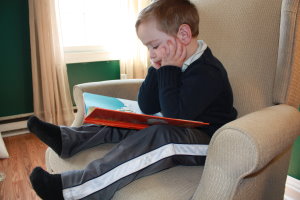
4. Invite Dr. Seuss into your house, and you might be tempted to serve green eggs and ham.
Okay, you can’t literally invite him into your home because Theodor Seuss Geisel died in 1991, but he did write and illustrate 44 books for children. One of my favorites is Did I Ever Tell You How Lucky You Are? It’s the story of a boy who meets a strange man who shows him how lucky he really is by singing about unlucky people. Although Dr. Seuss wasn’t big on writing message books, this one has a clear one: no matter what happens in life, it could be worse. So, cheer up!
Dr. Seuss books will not only brighten your child’s day, but they will probably make you laugh, smile, or giggle at the nonsense words and the amazing illustrations. If you bring Dr. Seuss’ legacy to your house, both you and your child will be lucky. You will have many priceless reading experiences, from The Cat in the Hat to The Grinch Who Stole Christmas.
5. Surround your child or children with mini-libraries of your own making.
Create small libraries in the kitchen, family room, and bedroom. Do you need to purchase expensive book shelves? Of course not: Cardboard boxes can be painted or decorated and transformed into miniature book cases. Another possibility is using baskets to collect books wherever you kids might sit down and read them.
If you surround your children with books, they will most likely grow up loving books, reading, and learning. They may also learn to love writing in the process. I have met many children writers at book festivals for many years, from Steve Kellogg to Jayne Yolen. And they all have two things in common: They grew up surrounded by books, and their parents read to them at a very early age. I don’t know what kind of reader Derek Jeter is, but it’s no surprise that he grew up next to a baseball field! It’s all about two magic experiences: proximity and practice, practice and proximity.
6. The library is for more than borrowing!
Find your nearest public library, and find out when they are hosting their next used book sale; almost all of them do it at least once each year. There you can buy used paperback books from 25 cents to 50 cents, and hardcover books from 50 cents to one dollar, depending on the library system. The turnover in books is faster nowadays because shelf space in libraries is scarcer and more books are being published than ever before. Last time I was at my local library sale I weighed books I bought just for the heck of it: ten pounds exactly for $2.50. Twenty-five cents a pound! What a deal!
Encourage your child to realize that the home is not the only place where people snuggle in and enjoy poetry. Libraries often have marvelous atmospheres that encourage reading out loud.
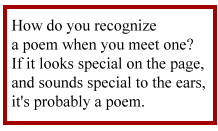
7. Give yourself and your children permission to explore and enjoy all sorts of poetry.
There are many varieties of poetry. There are ABC poems, Acrostic Poetry, Bio Poetry, Free Verse, Couplet Poetry, Diamond Poetry, Name Poems, Nonsense Poetry, Nursery Rhymes, Animal Poetry, Poems about Pictures, Odes of all sorts, Roses Are Red Poetry, I Used to Poems, When I Grow Up One Word Poems, Two Word Poems, and One Word Poems.
Now you might say, “I never heard of a One Word poem!” That's probably because you never sat in my poetry writing class. I invented the form with the kids that I taught: It’s an action word written on decorated piece of construction paper and it’s followed by an exclamation point. When Debra Ross, KidsOutAndAbout.com's publisher, read the first draft of this article when I sent it to her, she sent me back a one-word poem:
Gift!
Kids love creating these One Word Poems, and it adds powerful words to their vocabulary. It’s Awesome!
I happen to like free verse a lot. Robert Frost said, “Writing free verse is like playing tennis with the net down.” So, it wasn’t high on his list of favorites. All poetry has a certain structure to it, and follows some rules. Poets often write excellent poems by breaking the rules, but they can do that because they are making better word or meter choices, if they break some rules. Therefore, the door to what a poem is should be left wide open, even to let little friendly critters in like One Word Poems.
How do you recognize a poem when you meet one? If it looks special on the page, and sounds special to the ears, then it’s probably a poem. In Biology Class they dissect frogs, remove their guts, and analyze parts. Please don’t do that to poetry. It’s meant to be enjoyed, not ripped apart for meaning. If you don’t understand a poem after reading it two times, then the poet probably didn’t do his or her job right. The words of a poet should transform a page, not create a smoke screen. Toddlers will enjoy all sorts of poems, especially if you create a network of mini-poetry libraries right in their play areas. I am hoping that the first book your toddler chews on is a flannel poetry book.
8. Let your child participate in the “reading” of poetry by chanting the lines that are repeated.
In Waiting to See the Principal and Other Poems, I rely heavily on repetition in some poems. Repeating single words or sentences captures the attention of young children, and it invites them to say it when they know (from hearing the poem the first time around) that a special word or line is coming up. Repetition makes the poem more moving, memorable, and enjoyable.
In Waiting to See the Principal and Other Poems (written for kids 5-and up), I have a poem wherein I repeat this line numerous times: I can’t write today because…If I were writing only for toddlers, the line might have been: I can’t color today because…I like this poem for several reasons. It shows how important repeating can be; kids love to chant the line that is repeated, and I have a friend who is a college professor that teaches Freshman English and uses this poem each year with his students. So, is this a highbrow poem? It’s not at all. Teachers, whether in the classroom or living room, use what works.
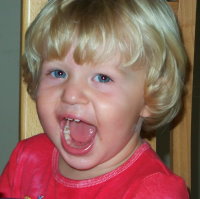
And this poem, “I Can’t Write Today Because,” makes kids laugh, giggle and think about the writing process:
I can’t write today because my paper is wrinkled. I can’t write today because I left my homework home. I can’t write today because I don’t have any lunch money. I can’t write today because my pinky needs a band-aid. I can’t write today because I don’t have my lucky pencil. I can’t write today because I don’t know the date. I can’t write today because it’s raining cats and dogs. I can’t write today because I forgot to brush my teeth. I can’t write today because my dog barfed on the kitchen floor. I can’t write today because my brand new T-shirt has a hole in it. I can’t write today because my underpants are too tight. I can’t write today because my mind is broke. I can’t write today because broke is my mind. Can’t write today!
Change the beginning of each line to I can’t color today because, and see if your toddler likes this poem.
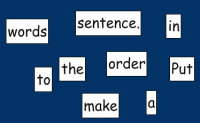
9. Use the Poetry Magnet Idea in your household.
That is, consider purchasing one of the following: Melissa & Doug Magnetic Wooden Alphabet, Kids’ Magnetic Rhyme Maker Word Kit, or Magnetic Poetry Really Big Words Large Magnets. If you read the reviews of them on Amazon.com, you will find advantages and disadvantages of each one, depending on the age of your child and what you really want to purchase. All children like to play with “words,” and actually hold them in their hands and—unfortunately—sometimes they go in the mouth.
My wife and I raised two daughters, and the surface of the refrigerator door was a Mecca of colorful artwork, photos, awards, and plastic alphabet letters that spelled out whatever we wanted to create. When your child is learning to read, it would be a wonderful activity to label in bright marker ink all the important items in your house on index cards. When we can name and identify things in the universe, it makes us feel more whole with our environment.
10. Enrich your toddler's poetry sense with color, crafts, and your secretarial skills.
Children love to color. They feel confident and happy when they are coloring. They love to use markers, paints, and crayons. And while they are coloring, they love to invent stories that you can help turn into simple poems by "playing secretary" for your child.
For example,you and your child can create lines of poetry by taking a sentence such as "I love Mommy," and then keep the flow going of that sentence by using other names in the family, but the sentence starts the same way each time with: "I love..." If your child isn't too verbal, he or she could point to treasured objects in the house. Then you write them down right under each other what is treasured or loved to form a poem. You can type it up, and read it together whenever both of you are in the mood. You can add pictures to the poem. The best part is that your child will know that the two of you created together something special.
Repetition helps to create your poem. You can repeat almost anything…I wish…I hope…I like …I love…When I grow up, I want to be…Your child doesn’t have to be able to write words to create poetry during Poetry Month. All your child needs is a few craft supplies, imagination, and a nurturing parent.
“There is nothing in a caterpillar that tells you it's going to be a butterfly.” ~R. Buckminster Fuller
Your toddler can learn to love words, poetry and reading too. And as Dr. Seuss wrote, "A person's a person, no matter how small." Why shouldn’t that little person fall in love with poetry?
 Joe "Silly" Sottile is the author of Waiting to See the Principal and Other Poems, Picture Poetry on Parade!, and Bathroom Vacation and Other Poems (out of print). Like his Facebook page Poetry Lovers and Others.
Joe "Silly" Sottile is the author of Waiting to See the Principal and Other Poems, Picture Poetry on Parade!, and Bathroom Vacation and Other Poems (out of print). Like his Facebook page Poetry Lovers and Others.


